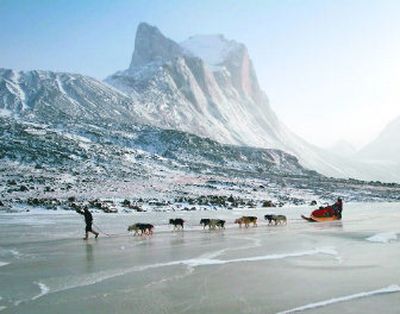Warming warning

The farther Will Steger clambered up the frozen cascade on the Weasel River, the better he grasped the immensity of the task ahead. The frozen river near Pangnirtung, Nunavut, Canada, twisted through a chaos of boulders, dropping three and four feet at a time. The channels of river, bereft of snow and treacherous to walk on, twisted and plunged among the mayhem of rocks. Occasionally, Steger would mutter something profane. He looked back downriver at the four dogsleds and his teammates in the Global Warming 101 Expedition. Somehow, each of those 700-pound sleds would have to be muscled up this labyrinth of ice.
And so the epic began. For most of eight hours, the team heaved and grunted and shoved and pulled. This was by far the biggest challenge the group had faced since leaving Iqaluit on Feb. 24.
Steger and seven teammates, including three Inuit hunters, will travel 1,200 miles across Baffin Island, interviewing Inuit people in villages along the way. Through the trek, Steger aims to show the rest of the world that global warming’s effects are being felt acutely by these Arctic people who are still tied to the land.
The team had now entered Auyuittuq National Park, whose name means “the land that never melts.” But, in truth, the glaciers that lie atop the mountains and drape into valleys have been receding for many years, older Inuit say. That’s why Steger brought his team here, where their video cameras can capture what remains of the glaciers and record Inuit elders talking about what climate change is doing to the land on which they depend.
As the team attacked the falls, the wind increased, and now it was driving a fine mist of snow and sand into the faces of the mushers and their 42 sled dogs. All eight team members, with the help of the straining dogs, would shove one sled up the jumble of rock and ice a few inches at a time. The dogs, feet flailing at the polished ice, did their best but were of little help.
It took the team six hours to cover no more than 200 yards, climbing perhaps 100 vertical feet, most of it near the top of the falls. That night, John Stetson filed a satellite-phone dispatch to base camp in Pangnirtung.
“I’ve traveled more than 100,000 miles by dog team,” he said, “and I’ve never in all those miles been on anything like what we went through today to get up the trail.”
“At first, it didn’t look like it was possible,” Steger reported in his dispatch that evening.
In the beginning of his expedition career, Steger went to the ends of the Earth for the sheer challenge of exploration.
In subsequent Arctic expeditions, he began to wed exploration with education.
Now, the 62-year-old Minnesota dogsledder is on a three-month expedition with Inuit hunters to document the consequences of global warming and bring them back to Congress.
Steger and six others, including three Inuit men, will depart Friday on a 1,200-mile trip across Canada’s Baffin Island, stopping to interview Inuit families in five villages. An education arm of the expedition will provide daily online updates to students and others.
Afterward, Steger plans to bring Inuit hunters and their families to Washington, D.C., to testify before Congress on global warming.
“My main goal is bringing about education, and using that to drive policy,” Steger said in a recent telephone interview. “It’s a golden time for that with the politicians we have in office.”
The trip will focus on changes that global warming is causing in the Arctic and how those changes have been detrimental to wildlife and the Inuit families who live there.
“I’m hoping to put a human face, a cultural face, on global warming,” Steger said. “If we can touch people heart-to-heart, when people have a sense for it, then that will change them. It will change their habits.”
Steger has experienced the effects of global warming firsthand. Ice shelves he once traversed by dog team in the Arctic and on Antarctica have broken away and fallen into the sea. A former science teacher, he has involved students in his expeditions since the advent of the Internet.
While traveling through Inuit villages in 2004, Steger met people whose lives were being affected directly by global warming.
“Everyone had a story about how it was affecting their hunting and their lives,” he said. “The ice is forming later and later and breaking up earlier. A lot of them are not able to get out for a lot of their hunts, especially for walrus. In a lot of these villages, 80 percent of their food comes from the land.”
As successful as he and others have been at getting out the message about global warming, Steger says it may be too late for some species.
“Things don’t look good for polar bears and walruses,” he said. “Regardless of what we do, we’re going to lose a portion of the Arctic biome.”
But he remains optimistic.
“We’re making big progress,” Steger said. “The science is overwhelming. There are still some skeptics, and we need to get these answered. But we have great solutions. We have 10 years to act on this to prevent a catastrophe for our kids.”